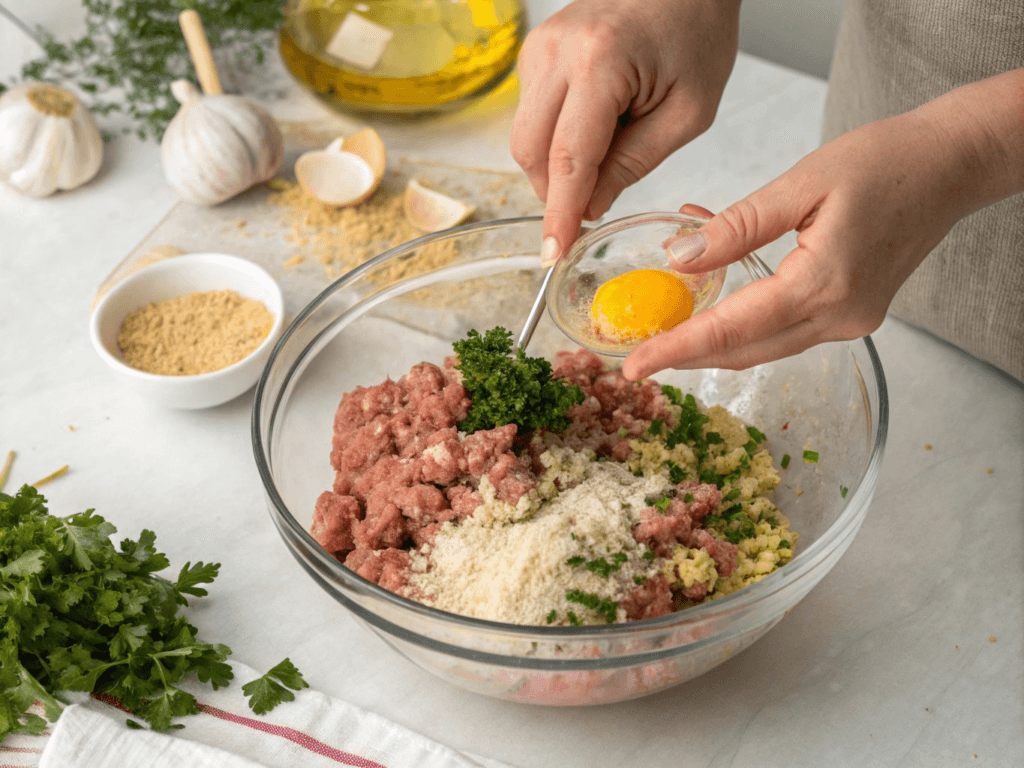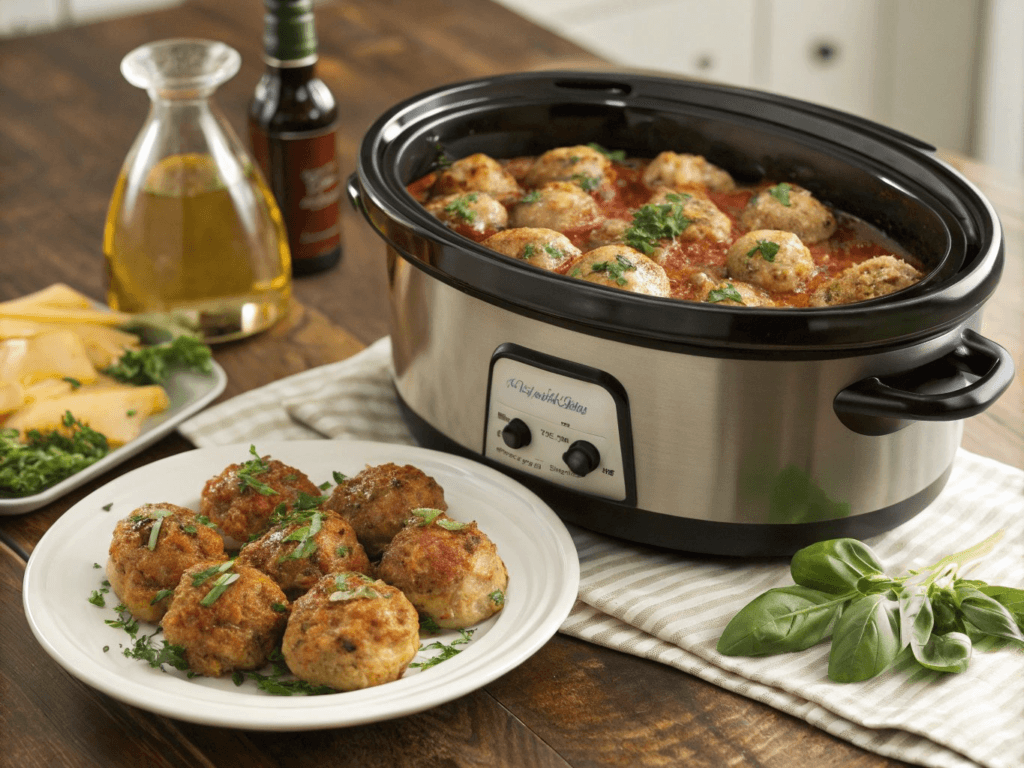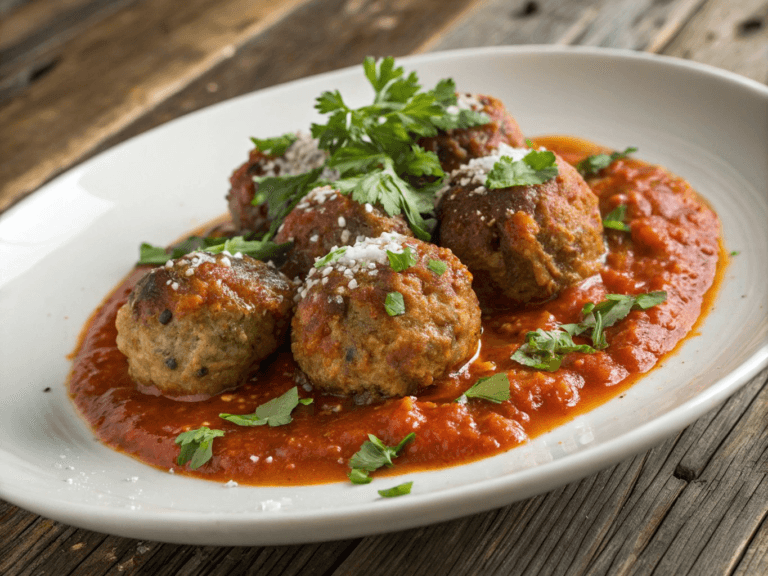How to Make Juicy Meatballs? Making juicy meatballs is a combination of art and science, a culinary adventure that can transform any meal into a celebration. Whether you’re preparing a cozy dinner at home or showcasing your cooking skills to friends and family, mastering the art of juicy meatballs is a must. So, are you ready to take your meatball game to the next level? Let’s dive right in!
Table of Contents About How to Make Juicy Meatballs
The Secret to Perfectly Juicy Meatballs
When it comes to meatballs, the secret lies in creating the right balance of ingredients and technique. The juiciest meatballs are all about incorporating moisture and flavor without overcomplicating the recipe. But what makes meatballs juicy? Let’s explore
Understanding the Science Behind Juiciness
At its core, juiciness is all about retaining moisture. When meat is cooked, it naturally tends to lose some of its juices. To address this, it’s important to trap extra moisture inside the meatball by using binders, fats, and cooking methods that effectively seal in all the goodness. Additionally, the right combination of ingredients can make all the difference in achieving that perfect texture.
Furthermore, the texture of a meatball depends heavily on how well the fat content is balanced with the lean meat. This is because fat melts during cooking, releasing moisture that keeps each bite tender and succulent. In other words, think of it like a sponge—without enough moisture, the meatball risks turning into a dry and crumbly disappointment. By paying attention to these key factors, you’ll consistently create meatballs that are both juicy and flavorful.
Best Ingredients for Making Juicy Meatballs
Great meatballs start with a thoughtfully chosen ingredient list. Here’s what you need to know:
Choosing the Right Meat Blend
The best meatballs often combine different types of meat. and sometimes veal creates a rich, flavorful profile. The key? Go for a blend with about 20% fat to ensure enough moisture.
Adding Fats for Extra Moisture
If your meat blend is too lean, don’t be afraid to add fat. This could be in the form of grated cheese, a touch of olive oil, or even finely diced bacon. These additions act like little bursts of juiciness, ensuring every bite is flavorful.
The Role of Binders in Meatballs
Binders are the glue that holds your meatballs together while also adding moisture. Here’s a closer look:
Breadcrumbs and Milk Mixture
A classic trick is to soak breadcrumbs in milk until they’re soft and mushy. This creates a paste that not only binds the meat but also locks in moisture. Want an extra pop of flavor? Use buttermilk instead of regular milk!
“A good meatball isn’t just held together by skill—it’s held together by the perfect binder.”
Egg: To Add or Not to Add?
Eggs are another traditional binder, but too many can make your meatballs dense and rubbery. One egg per pound of meat is usually enough to maintain structure without sacrificing tenderness.
Step-by-Step Guide on How to Make Juicy Meatballs

Now that you know the basics, it’s time to roll up your sleeves and get cooking! Follow these steps to achieve meatball perfection.
Preparing the Meat Mixture
- Choose Your Ingredients: Combine your ground meats, soaked breadcrumbs, grated onion (for extra moisture), minced garlic, and seasonings like salt, pepper, parsley, and Parmesan.
- Mix Gently: Overmixing can lead to tough meatballs. Use your hands (they’re your best tools!) and stop as soon as everything is evenly distributed.
“Mixing meatballs is like a delicate dance—too rough, and you lose the magic.”
Forming the Perfect Meatball Shape
Tips for Consistent Sizes
Using an ice cream scoop or a tablespoon ensures each meatball is the same size, which helps them cook evenly. Plus, it looks more professional when serving!
How to Avoid Common Mistakes When Making Juicy Meatballs
When shaping the meatballs, handle them gently. Compressing them too much can result in a dense texture. Think of it as rolling a snowball—just enough pressure to hold its shape.
Cooking Techniques for Juicy Meatballs
The way you cook meatballs plays a crucial role in how juicy they turn out. Here are your best options:
Pan-Frying for a Crispy Exterior
Pan-frying meatballs gives them a golden crust that locks in the juices. Heat a skillet with oil, add your meatballs, and cook until they’re browned on all sides. But don’t overdo it—you’ll finish cooking them in the sauce.
Baking for Even Cooking
Baking is a less hands-on method that ensures even cooking. Line a baking sheet with parchment paper, place your meatballs on it, and bake at 375°F (190°C) for 15-20 minutes.
Simmering in Sauce for Enhanced Flavor
For the juiciest results, simmer your meatballs in a flavorful sauce for 15-30 minutes after browning or baking. This method infuses the meatballs with even more moisture and enhances their taste.
“A meatball without a sauce is like a story without a plot—good, but not unforgettable.”
Common Problems When Learning How to Make Juicy Meatballs
Even the most seasoned cooks encounter challenges when making meatballs. But don’t worry—we’ve got you covered! Here are the most common meatball mishaps and how to fix them.
Why Do Meatballs Turn Out Dry?
Dry meatballs are a letdown, right? Nobody wants to bite into a tough, crumbly ball of disappointment. This happens when there isn’t enough fat or moisture in the mix, or when they’re overcooked.
Solutions:
- Increase the Fat Content: Use a meat blend with at least 20% fat, or mix in fatty ingredients like grated cheese or finely diced bacon.
- Add More Moisture: Soaked breadcrumbs, grated onions, or even a splash of broth can work wonders.
- Cook Carefully: Monitor cooking times and use a meat thermometer to ensure the internal temperature doesn’t exceed 165°F (74°C).
“If your meatballs are dry, remember—juiciness starts with the right balance of ingredients.”
How to Prevent Meatballs from Falling Apart
Ever had a meatball crumble before it even hits the plate? This can happen if your binders are inadequate or the mixture wasn’t handled properly.
Solutions:
- Use Effective Binders: Soaked breadcrumbs and eggs are essential for holding everything together. For gluten-free options, try almond flour or crushed crackers.
- Don’t Overmix: Gentle mixing helps the ingredients stick without losing their structure.
- Chill Before Cooking: Once formed, refrigerate the meatballs for 15-20 minutes. This helps them firm up and hold their shape during cooking.
Secrets to Perfectly Juicy Meatballs
Cooking meatballs is just the beginning; what comes next can greatly enhance their flavor and texture. How you choose to serve them plays a crucial role in elevating your dish. For instance, pairing them with a rich tomato sauce, creamy gravy, or a tangy yogurt dip can bring out their best flavors. Additionally, serving them with complementary sides like pasta, rice, or crusty bread ensures a satisfying meal.
Moreover, proper storage is essential to maintain their quality. When storing leftovers, it’s important to let the meatballs cool slightly before placing them in an airtight container. Furthermore, reheating them gently in a sauce or broth prevents them from drying out and keeps them as tender as when they were first made. By taking these extra steps, you can ensure your meatballs remain delicious even after the cooking is done.
Pairing Meatballs with Sauces and Dishes
The sauce you choose can elevate your meatballs to new heights. From classic marinara to creamy Swedish-style gravies, the options are endless. Want a bold twist? Try pairing them with spicy arrabbiata or savory mushroom sauce.
For serving, meatballs shine in various settings:
- Over spaghetti for a traditional Italian vibe. 🍝
- In a sub sandwich for a hearty lunch.
- On toothpicks as party appetizers.
Freezing Meatballs for Later Use
Making meatballs in bulk? Smart move! Freezing them ensures you have a quick, ready-to-go meal for busy days.
Steps for Freezing:
- Cook the meatballs fully and let them cool completely.
- Place them on a baking sheet in a single layer and freeze until solid.
- Transfer to a freezer-safe bag or container. Label with the date to keep track.
Frozen meatballs can last up to three months and are easy to reheat in a sauce or microwave.
Reheating Without Losing Moisture
Reheating can be tricky—you want your meatballs warm, not dry. The best method? Simmer them in a sauce for about 10 minutes. This rehydrates them while infusing even more flavor. If you’re in a rush, microwaving with a damp paper towel over the dish helps retain moisture.
“Leftover meatballs don’t have to taste like leftovers—reheat them the right way, and they’re just as good as fresh!”
Flavorful Variations to Make Juicy Meatballs Unique
Classic meatballs are great, but experimenting with flavors and styles can take them to a whole new level.
Meatball Recipes from Around the World
Meatballs aren’t just an Italian thing; in fact, cultures worldwide have their own unique and delicious takes on this beloved dish. With so many variations, there’s a flavor to suit every taste. Let’s take a journey through some of the most popular meatball recipes from around the globe.
Swedish Meatballs
These tender, creamy meatballs are a staple in Swedish cuisine. Typically served with a rich, velvety gravy and a dollop of tangy lingonberry jam, they make for an irresistible comfort food. Moreover, the combination of sweet and savory flavors makes them stand out.
Asian-Inspired Meatballs
If you’re looking for bold flavors, Asian-inspired meatballs are a fantastic choice. Infused with ingredients like soy sauce, ginger, and garlic, these meatballs are anything but ordinary. Additionally, they’re often coated in a sweet-and-spicy glaze, which pairs beautifully with steamed rice or noodles.
Middle Eastern Kofta
In the Middle East, meatballs take the form of kofta. These are often seasoned with a mix of cumin, coriander, and parsley, giving them a distinctive, aromatic taste. What’s more, they’re usually grilled to perfection or served with a tangy yogurt sauce for added richness.
Each of these recipes offers a unique twist on the classic meatball, showcasing how versatile this dish can be. So, why not try one of these global variations for your next meal? It might just become a new family favorite!
Incorporating Vegetables and Cheese
Want to sneak in some extra nutrition or indulgence? Adding grated zucchini, carrots, or spinach to your mixture keeps it moist while boosting health benefits. For cheese lovers, stuffing each meatball with a cube of mozzarella creates an ooey-gooey center that’s impossible to resist. 🧀
Using Different Meats and Seasonings
Traditional meat blends are fantastic, but don’t be afraid to branch out.
- Turkey or Chicken: For a leaner option, these meats work well with added moisture like ricotta cheese.
- Seafood: Shrimp or fish meatballs, anyone? These are light, delicate, and perfect with lemony sauces.
Creative Twists on Juicy Meatballs
If you’re looking to explore unique recipes, why not try combining meatballs with other comforting dishes? One standout option is pairing meatballs with gnocchi in a flavorful Tuscan-inspired slow cooker recipe. This method enhances the juiciness of the meatballs as they simmer in a rich, creamy sauce. For a detailed recipe, check out this amazing guide to Slow Cooker Tuscan Chicken Meatballs with Gnocchi.

Pro Tips for Making Juicy Meatballs Every Time
Let’s take your skills from good to great with these pro tips.
Using a Meat Thermometer for Accuracy
Guesswork is often the enemy of perfection, especially when it comes to cooking meatballs. Therefore, investing in a reliable meat thermometer is a game-changer. Not only does it help you achieve the ideal internal temperature of 160-165°F (71-74°C), but it also ensures that your meatballs are cooked safely and evenly. Furthermore, using a thermometer takes the stress out of wondering if they’re done, allowing you to focus on other aspects of your dish. Ultimately, this small tool guarantees food safety without the risk of overcooking and losing those juicy, tender textures everyone loves.
Understanding Safe Cooking Temperatures for Meatballs
Cooking meatballs to the correct internal temperature is crucial to ensure both safety and flavor. Ground meats, including beef, pork, and chicken, should reach an internal temperature of 160°F (71°C) to 165°F (74°C) to kill harmful bacteria without overcooking them. Using a meat thermometer is the best way to guarantee accuracy.
For more detailed information about safe cooking temperatures for various types of meat, you can visit the official USDAFood Safety and Inspection Service website. This trusted resource offers comprehensive guidelines to help you prepare meals with confidence.
Adding a credible external link like this enhances the value of your content while supporting readers with reliable information. 😊
Experimenting with Flavors and Textures
Think beyond the basics. Add spices like smoked paprika, turmeric, or fennel seeds to your mixture. Want extra texture? Toss in chopped nuts or seeds for a surprising crunch.
Frequently Asked Questions (FAQs)
How do I keep my meatballs from sticking to the pan?
To prevent sticking, preheat your pan and add enough oil to coat the surface evenly. Ensure the pan is hot before adding the meatballs. For baked meatballs, using parchment paper or a silicone mat works wonders.
Can I make meatballs without breadcrumbs?
Absolutely! You can substitute breadcrumbs with almond flour, crushed crackers, cooked quinoa, or even mashed potatoes. These alternatives still act as binders while adding unique textures and flavors.
What’s the best way to season meatballs?
Seasoning is all about balance. Use salt, pepper, and your favorite herbs like parsley, oregano, or basil. For a punch of umami, grated Parmesan cheese or a splash of soy sauce can elevate the flavor profile.
Should I cook meatballs before adding them to the sauce?
While it’s not mandatory, browning the meatballs before simmering in the sauce adds depth of flavor and helps them hold their shape better. If you prefer softer meatballs, you can add them raw and let them cook gently in the sauce.
Can I make meatballs without eggs?
Yes! If you’re avoiding eggs, use alternatives like flaxseed meal mixed with water, mashed potatoes, or even ricotta cheese. These options still provide binding without compromising texture.
How long can I store cooked meatballs in the fridge?
Cooked meatballs can be safely stored in an airtight container in the fridge for up to four days. For longer storage, freeze them and enjoy within three months.
Conclusion: Your Path to Juicy Meatball Perfection
Making juicy meatballs is a rewarding culinary adventure that combines science, creativity, and passion. Whether you’re a seasoned chef or just starting in the kitchen, following these tips and techniques will help you achieve consistently delicious results. From choosing the perfect meat blend to mastering cooking techniques, every detail matters when crafting the ultimate meatball.
Remember, cooking isn’t just about the food—it’s about the experience. Take your time, enjoy the process, and don’t be afraid to experiment. Soon enough, you’ll be the go-to meatball master in your circle, with everyone begging for your secret recipe. (You can share it or keep them guessing—it’s up to you!)

